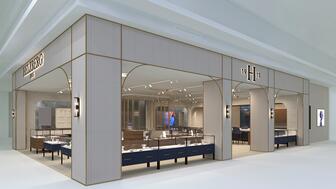In the recent multi-shipment seizure, CBP also found counterfeit Audemars Piguet, Moncler, and Chrome Hearts items.
Judge Drops Thousands from Sterling Discrimination Case
Federal judge Jed S. Rakoff ruled that an arbitrator overstepped her bounds in including women who did not opt into the class.
New York--A federal judge ruled last week that the arbitrator in charge of the sex discrimination case against Sterling Jewelers overstepped her bounds in including women who did not opt into the class, and he cut thousands of women from the case.
Arbitrator Kathleen A. Roberts ruled in February 2015 that women could pursue claims of pay and promotion discrimination against the retailer as a class, and certified a class of approximately 70,000 individuals that included all women who had worked for Sterling within a specific range of dates, regardless of whether or not they had said they wanted to be part of the case.
Sterling appealed the decision twice and in July 2017, the U.S. Second Circuit Court of Appeals sided with the retailer, ruling that the issue of whether or not an arbitrator has the power to include people who do not opt into the class had never been “squarely addressed,” and remanded the issue to the U.S. District Court in Manhattan.
On Jan. 16, federal Judge Jed S. Rakoff ruled that the arbitrator does not have this power, writing in his decision, “Arbitrators are not judges. Nowhere in the Federal Arbitration Act does Congress confer upon these private citizens the power to bind individuals and businesses except in so far as the relevant individuals and businesses have bound themselves.”
“The court finds that the arbitrator here had no authority to decide whether the RESOLVE agreement permitted class-action procedures for anyone other than the named parties who chose to present her with that question and those other individuals who chose to opt in to the proceeding before her.”
RESOLVE is the name for Sterling’s internal dispute resolution system; upon hire, all employees agree to settle any workplace disputes in private arbitration, a practice some lawmakers are looking to force companies to change because, they say, it can discourage women who have been discriminated against or sexually harassed from speaking up.
The judge’s ruling cuts the size of the class down from 70,000 to the approximately 250 women who either filed the original arbitration claim under Title VII--which covers claims of promotion discrimination--or were part of the claim before the 2015 class certification that Rakoff just overturned.
There are, however, 10,000 other women who opted into a separate class in 2016 under claims brought under the Equal Pay Act (EPA).
Washington, D.C.-based attorney Joseph Sellers, who represents the women who filed
“At the very least, we think we should proceed to trial on behalf of the claims of more than 9,000 women. We hope the Second Circuit (Court of Appeals) will allow the balance of the women’s claims,” he said, referring to the 60,000 women excluded by Rakoff’s decision.
David Bouffard, the vice president of corporate affairs for Sterling parent company Signet Jewelers Ltd., said the company will be challenging the certification of the EPA class as well.
RELATED CONTENT: EEOC, Signet Reach Settlement in Discrimination CaseThe ruling, and subsequent appeal, is the latest in a convoluted case that has stretched on for nearly a decade and has included numerous rulings and appeals on the issue of allowing the women to pursue their claims as a class even though their case has to be heard in arbitration.
The sex discrimination case against Sterling began back in 2008 when a group of 12 women who used to work at the retailer’s stores accused it of paying women less than men and passing them over for promotions.
Filed as part of that case but not released until this past spring were more 1,000 pages of sworn statements obtained by The Washington Post that went beyond allegations of pay and promotion discrimination, painting a portrait of Sterling in the late ‘90s and early 2000s as a boys’ club where the sexist culture started at the top with now-departed CEO Mark Light.
These claims are not part of the class arbitration, and Sterling has repeatedly disputed them, saying they give a distorted and inaccurate picture of the company’s culture.
The Latest

Helzberg’s Chief Retail Officer Mitch Maggart shared details about its tests of a new store concept rooted in an elevated luxury experience.

Jewelers of America execs and National Jeweler editors discuss tariffs, the sky-high gold price, and the engagement that broke the internet.

How Jewelers of America’s 20 Under 40 are leading to ensure a brighter future for the jewelry industry.

The National Jeweler editors revisit the most noteworthy industry happenings and design trends from 2025.


Need a gift for the cat lover who has everything? Look no further than our latest Piece of the Week.

It purchased the “Grosse Pièce,” an ultra-complicated Audemars Piguet pocket watch from the ‘20s, for a record-breaking price at Sotheby’s.

Roseco’s 704-page catalog showcases new lab-grown diamonds, findings, tools & more—available in print or interactive digital editions.

The lab-grown diamond grower now offers custom engagement and fashion jewelry through its Kira Custom Lab Jewelry service.

Chandler got his start at Michelson Jewelers and has served as DCA president and CEO since 2001. He will retire at the end of the month.

The boutique is slated to open this week inside Terminal 8, offering pre-owned Rolex watches and more to international travelers.

Sponsored by Digital Monitoring Products

The special-edition egg pendant ingested in a New Zealand jewelry store was recovered after a six-day wait.

Associate Editor Natalie Francisco plays favorites with Piece of the Week, selecting a standout piece of jewelry from each month of 2025.

The “Love and Desire” campaign is inspired by the magic that follows when one’s heart leads the way, said the brand.

Two awardees will receive free tuition for an educational course at the Swiss lab, with flights and lodging included.

Berta de Pablos-Barbier will replace Alexander Lacik at the start of January, two months earlier than expected.

Sotheby’s held its first two jewelry sales at the Breuer building last week, and they totaled nearly $44 million.

Winners will receive free registration and lodging for its fourth annual event in Detroit.

Here are six ideas for making more engaging content for Instagram Reels and TikTok, courtesy of Duvall O’Steen and Jen Cullen Williams.

The honorees include a notable jewelry brand, an industry veteran, and an independent retailer.

Carlos Jose Hernandez and Joshua Zuazo were sentenced to life without the possibility of parole in the 2024 murder of Hussein “Sam” Murray.

Yood will serve alongside Eduard Stefanescu, the sustainability manager for C.Hafner, a precious metals refiner in Germany.

The New Orleans jeweler is also hosting pop-up jewelry boutiques in New York City and Dallas.

Set in a Tiffany & Co. necklace, it sold for $4.2 million, the highest price and price per carat paid for a Paraíba tourmaline at auction.

The jeweler’s “Deep Freeze” display showcases its iconic jewelry designs frozen in a vintage icebox.

Take luxury gifting to new heights this holiday season with the jeweler’s showstopping 12-carat sphene ring.


























